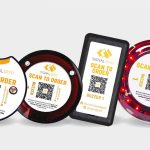Table of Contents
For any business, having a proper queuing system is essential. Long waiting time and messy queue management can cause customers to lose interest and develop negative impressions about your brand. This can result in walk-aways, customer dissatisfaction, and finally losing sales.
Fortunately, businesses can now manage customer’s queueing experiences through Queue Management Systems (QMSs), and are able to provide a more streamlined process and engage customers.
What is a Queue Management System?
In today’s society, using queues effectively is a must for a successful business. Queuing process may be laborious and tiring, and customers do not enjoy it. However, when product demand exceeds the ability to supply, the existence of queues becomes inevitable.
This is where the Queue Management Systems (QMSs) come in. An effective QMS can help you manage your customers’ queuing experiences, increase your sales, reduce labour cost and enhance your brand’s reputation.
There are various types of QMSs available in the market; ranging from manual ticket dispensers to fully customisable systems that integrate with your business. Regardless of the types, they all share the characteristics of helping you examine the number of customers, how they are served and demand of your products etc. By performing the in-depth evaluation of these factors, businesses can have a better understanding of their customers and implement solutions for improvement when necessary.
Examples of Queue Management Systems includes:
- Ticketed Queue System
- Display Number Call Queue System
- Digital Signage or TV Display Queue System
- Online Virtual Appointment Booking System
- Smartphone SMS Alerts
- Mobile Queuing Apps
- Self-Service Kiosks
How does a Queue Management System work?
For the sake of simplicity, most QMSs are made from the basic model of having a transmitting device and a receiving device, and created to provide a positive and efficient queuing journey for customers. They can also help to improve operational efficiency and reduce labour cost. For instance, let’s take a look at SIGNALGRYD Queue Management Systems.
SIGNALGRYD Queue Management Systems can be categorised into 4 types as follows:
Linear Queue System
Linear Queue System works seamlessly through a planned queue process, and is most suitable for businesses with a single queue and multiple check-out counters. For example, pharmacies and healthcare centers, retail and departmental stores, or commercial premises where there are blind spots between the counters and the customers.
Ideal for:
- When customers / guests are already in a single line queue
- Businesses with blind spots in the premise, which block customers’ view of available counters
How It Works:
Linear Queue System includes transmitter call buttons and receiver display panel. When a service counter becomes available, the designated counter staff will press a call button to usher in the next customer. A signal will be then transmitted to the display panel located near the queue, and subsequently, the display panel will alert the customer to proceed to the available counter to receive service.
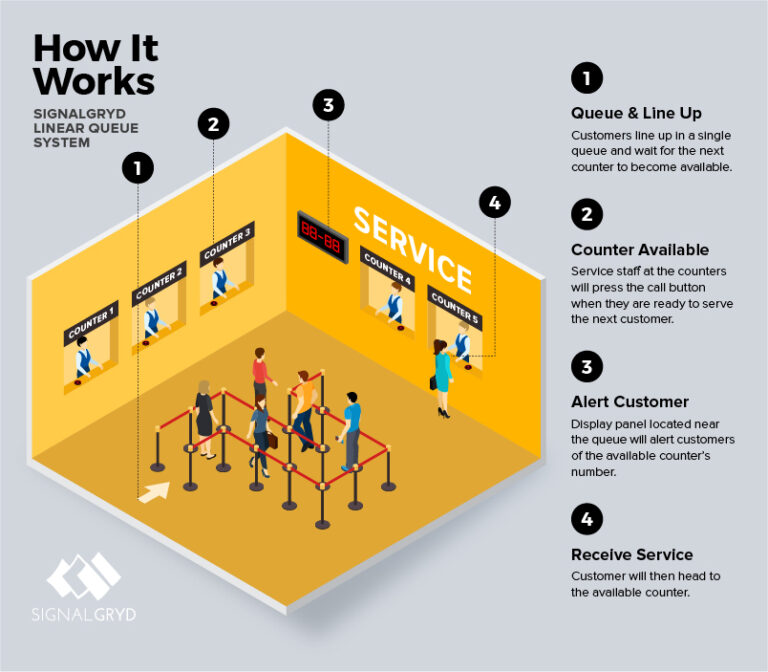
Ticketed Queue System
Ticketed Queue System includes ticket printer, transmitter keypad and receiver display panel. The keypad works as a transmitting device while the display panel works as a receiving device that indicates the counter number that the customer should head to. This system is ideal for businesses with long waiting lines such as banks, service centers, community and education centers, governmental offices or establishments.
Ideal for:
- Businesses with expected longer waiting times
- Allowing customers to stay seated or roam around whilst waiting for their turn
How It Works:
Upon arrival, a customer first retrieves a queue number from the printer, and be seated or roam around the vicinity whilst waiting for their turn. When a counter is available, the service staff will use the transmitting keypad to enter the next queue number in sequence, as well as the available counter number. The entered data will then be transmitted to the overhead display panel, which in turns will notify the customer to proceed to the respective counter.
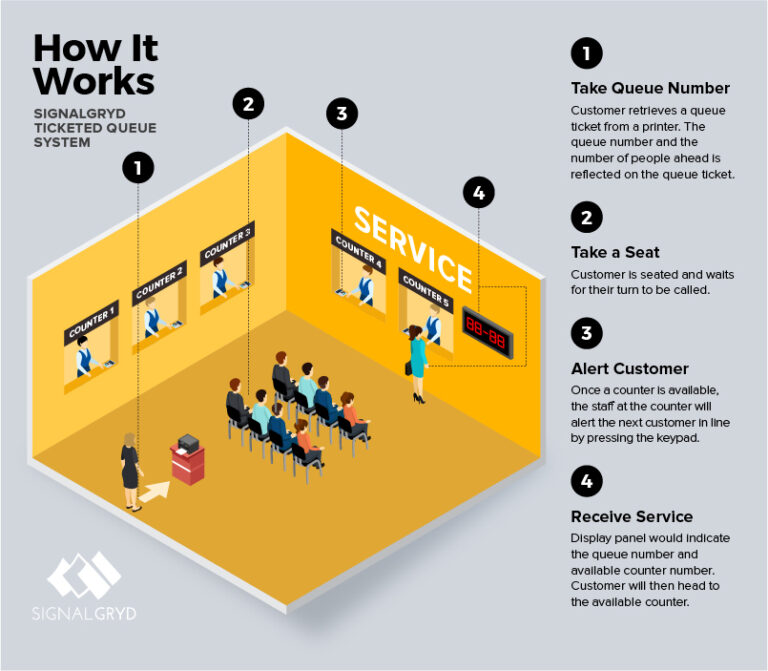
Queue Number System
Queue Number System is simple to operate and most suitable for small food and beverage shops such as bubble tea outlets and quick service stalls. This system includes a transmitter keypad and a receiver display panel.
Ideal for:
- Fast turn around of orders
- Not too long queues
- Businesses with customers usually waiting around the vicinity
How It Works:
In this system, customers obtain their queue numbers from the receipt provided by the cashier. Once the food/product/service is ready, the staff will press the keypad transmitter to call the respective queue number. The transmitted number will then be shown on the display panel to inform the customer for collection.
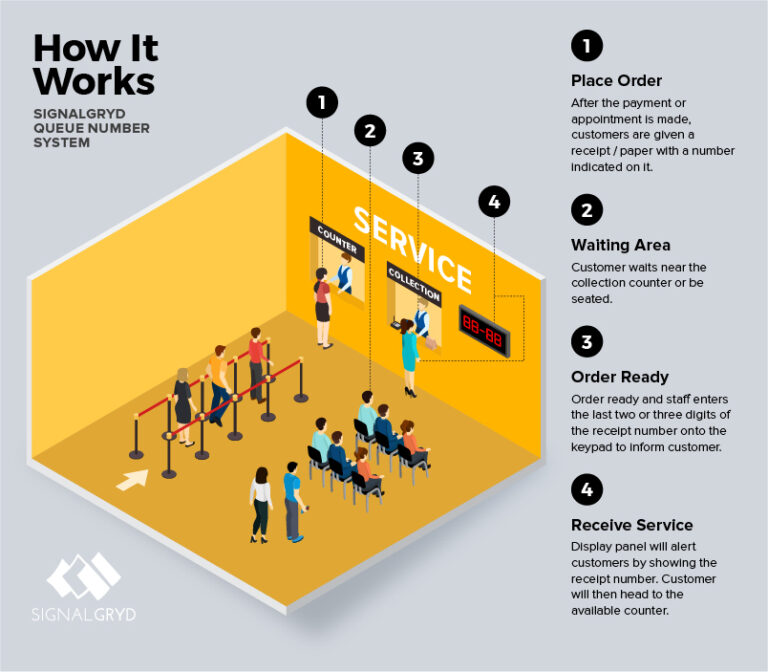
TV Queue Number System
TV Queue Number System consists of a keypad transmitter, a TV setup box, and a remote control. The system integrates with your existing TV display, to engage customers through images, videos or promotional contents. The layout on your TV display is fully customisable, and is the most optimal choice for businesses that wish to shorten the customer’s perceived waiting time through interactive engagements. This system is suitable for larger establishments such as banks, hospitals, commercial headquarters, and governmental centers.
Ideal for:
- Larger establishments with spacious seating / waiting areas
- Businesses on expansion / upsizing
- Retaining customers and increasing sales channels
How It Works:
Upon payment or appointment made, customers are given a receipt or a paper with a number indicated on it. Customers can then be seated and wait for their turn while watching the TV display. Once their turn arrives, the designated staff will enter the receipt or queue number onto the transmitting keypad to inform the customer. TV Display will receive the transmitting signal, and subsequently will alert the customer by showing the receipt number alongside the promotional content. The customer can then head to the counter to receive service.
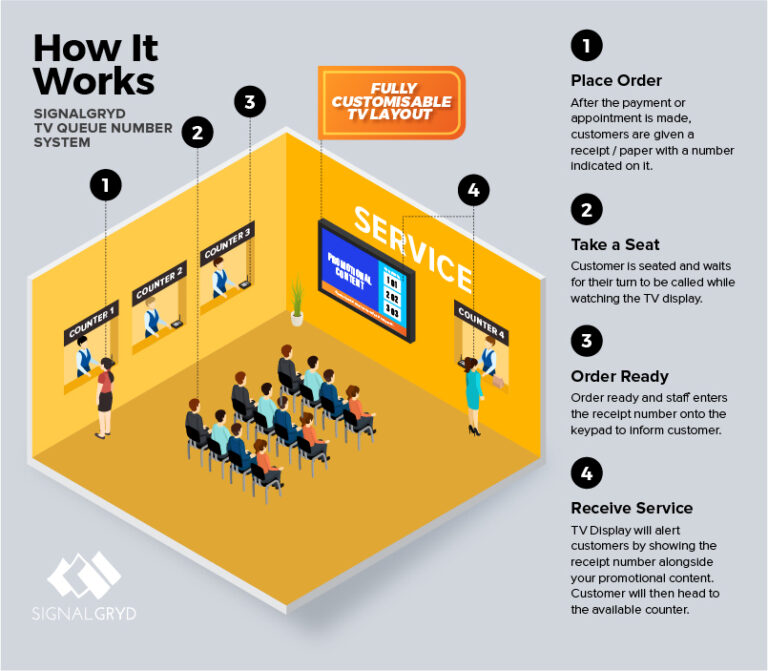
This generally summed up the process on how SIGNALGRYD queue management systems work and which businesses and industries are suitable for each system.
With the rise of modern technology, businesses today must provide faster and more efficient service to customers and they cannot afford to ignore the value of customers’ queuing experiences.
SIGNGALGRYD queue management systems can help to address this concern, and enhance your business through a planned service flow throughout all service touch points. You may find out more on how we can help your business by contacting us.



